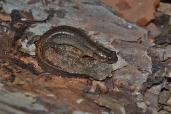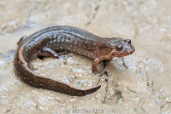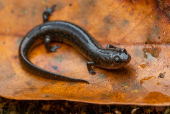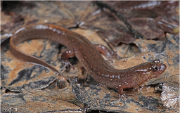Valentine's Southern Dusky Salamander (Desmognathus valentinei)
Description: Despite its close resemblance to D. holbrooki, it has some morphological differences. It has a larger body structure than D. holbrooki and has nondescript dorsal markings instead of the crisply defined blotches on other Desmognathus species. They also differ in aspects of the skull, and the tails of D. valentinei have a bladelike shape instead of narrowing to a tip. D. valentinei has a darker ventral side, often with a reddish or orange-striped tail and distinct paired pink/orange/red dorsal spotting.
Habitat: This species occurs in swampy, muddy, bottomland swamps and sloughs.
Range: It is found in the Gulf Coast region, where it ranges from the Mobile Bay region of Alabama west through the southern half of Mississippi to eastern Louisiana.
Found in these States:
AL |
LA |
MS |
TX
Diet: Various small invertebrates
Reproduction: In gravid females, the enlarged ova can be seen as a light yellow coloration through the ventrum anterior to the hind limbs. Courtship behaviors consists of a "waltz" like dance that is also present in at least one other lineage of Desmognathus. The dance lasts an average of 2.5 minutes and as long as 7 minutes in some instances. Observations of a female along with her newly-hatched offspring on muddy earth indicate that D. valentiniei oviposits on land rather than in water. Hatchlings undergo indirect rather than direct development. One gravid female was brought into captivity and laid two clutches of 31 and 27 eggs. All 31 eggs of the first clutch and 9 of the second clutch hatched between 56 to 59 and 46 days, respectively. The 31 larvae all reached adulthood in captivity and metamorphosed between 70 to 90 days after hatching
Status: Listed as Least Concern in view of its relatively wide distribution and presumed large population.
»» Kingdom: Animalia - Animals
»» Phylum: Chordata - Chordates
»» Subphylum: Vertebrata - Vertebrates
»» Class: Amphibia - (Amphibians)
»» Order: Caudata - Salamanders
»» Family: Plethodontidae - Lungless Salamanders
»» Genus: Desmognathus
»» Species: Desmognathus valentinei - Valentine's Southern Dusky Salamander
This article uses material from the Wikipedia article "Valentine's Southern Dusky Salamander", which is released under the Creative Commons Attribution-Share-Alike License 3.0. Content may have been omitted from the original, but no content has been changed or extended.
|













